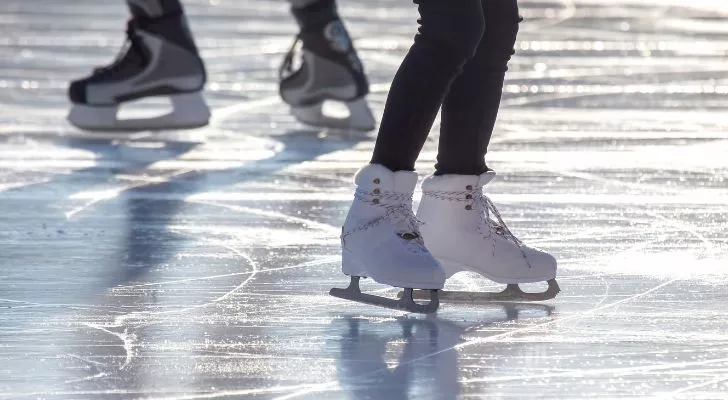Around the same time pyramids were being built in Egypt, early Scandinavians were strapping things to their feet and sliding across ice.
Ice skating evolved over the centuries, from primitive to space-age, and is now enjoyed by millions of people around the globe.
Come along as we journey through the history of skating.
The oldest ice skates ever found were extracted from the bottom of a lake in Switzerland and carbon-dated to 3000 B.C., making them 5,000 years old.
However, it’s thought that a primitive form of skating first became common around Finland around 4,000 years ago.
The first skates were made of long animal bones cut flat on the bottom and polished smooth, with holes drilled for straps to attach them to the foot. Wooden poles thrust between the legs provided propulsion.
Researchers theorize that these first early skates were invented not so much for sport but more as a means of transportation. Finland has about 187,888 lakes, and it’s easier to cross them on skates in winter.
The oldest known skates with metal blades, made of copper, were found in Scandinavia and date back to about 200 A.D. The next metal blades appeared on the scene in the 13th century, attached to wooden blocks strapped to the foot.
By the 1500s, blades curved upwards at the toe to prevent the tip from getting stuck in the ice and tripping the skater.
Ice skating became available to the masses with the invention of steel blades, which could easily be clamped to any shoe. Designed by Edward Bushnell of Philadelphia, Pennsylvania, in 1850, skates were now durable, effective, mass-produced, and inexpensive.
Around 1865, ice skating was revolutionized by ballet dancer Jackson Haines. He was the first to introduce graceful moves and athletic jumps, turning it into an art form and laying the foundation of figure skating.
Jackson Haines also improved the design of skates by screwing the blades directly to the boots and added the “toe pick,” a serrated edge that gives skaters the grip needed to perform maneuvers.
The world’s first commercially successful artificially frozen ice rink was installed in London, England, in 1876. It was designed by a meat distributor who had invented a method of freezing meat to survive long sea journeys.
The first rink in the U.S. opened in Madison Square Garden in New York City in 1879. Skating became a year-round activity. As ice rinks spread, competitive sports skating flourished.
The National Skating Association of Great Britain became the first governing organization for skating in 1879. The U.S. followed in 1886 with the National Amateur Skating Association. Together, they formed the International Skating Union (ISU), which governs skating today.
The first world championships for speed and figure skating were held in 1896. Only men were allowed to compete. Only four men competed. Though women proved themselves talented skaters, they were not allowed to compete.
The doors to competitive ice skating for women were forced open by Madge Syers. In 1902, she showed up at the World Championships. Judges wanted to ban her, but she insisted they point out the place in the rulebook where women were prohibited. No such rule existed. The rules were subsequently rewritten to allow women.
The term “figure skating” originated because competitions involved testing skaters to see how accurately they could carve designs on the ice, including figure 8s, roses, stars, and crosses. This exercise was boring for spectators and was eventually dropped.
Ice skating boomed due to Norway’s Sonja Henie, who won more medals than any other skater in history throughout the 1920s and 1930s. She discarded stuffy routines and somber outfits, instead performing theatrical routines in short skirts with gleaming white skates.
A problem with rinks was that the ice was easily scarred by blades. Frank Zamboni, who owned a rink in California, patented the ice-resurfacing machine in 1953. It scraped the top layer of ice off and spayed a layer of hot water.
In 1954, the Boston Bruins became the first National Hockey League team to purchase a Zamboni. In 1957, the National Collegiate Athletic Association decreed all new rinks would have one. By 1960, they appeared at the Olympics.
Many classic skating moves were named after those who invented them: Alois Lutz, Axel Paulsen, Ulrich Salchow. The camel spin was likely developed by a skater named Campbell from Australia.
The axel, considered skating’s most difficult jump, involves taking off while facing forward and landing backward. The only person who has ever accomplished a quadruple axel – turning 4.5 times in the air – is U.S. skater Ilia Malinin in 2022.
Skating became the first winter sport added to the Olympics in 1908. Just 21 skaters, both men and women, competed in four different figure skating events.
Ice hockey made its Olympic debut in 1920, though only men competed. Not surprisingly, Canada took the gold. The U.S. won silver and Czechoslovakia won bronze. Women’s hockey was added in 1998.
Speed skating became an Olympic event at the world’s first official Winter Olympics in Antwerp, Belgium, in 1924. A women’s speed skating event in 1932 was for exhibition purposes only. Women’s speed skating was officially added in 1960.
In men’s speed skating, Pavel Kulizhnikov of Russia won the 500-meter race in 2019 with an average speed of 33.28 mph (53.56 km/h), faster than any other human had ever skated before in recorded history.
You’ll never see skating uniforms decorated with feathers. Why? Because points are deducted if any piece of the costume falls off and lands on the ice. Feathers are very delicate and tend to fall apart easily.
The fastest recorded spin on ice skates is 342 RPM (revolutions per minute) by Olivia Oliver of Canada in 2015. That’s just under six turns per second.
The world’s largest indoor ice rink is in the city of Nizhny Novgorod in Russia. It has a surface area of 135,625 ft² (12,600 m²), which is a little over three acres. It can accommodate 15,000 spectators.
The world’s longest ice skating trail is 18.63 miles (29.98 km) long. It’s formed by the freezing of the Lake Windermere Whiteway in Invermere, British Columbia, Canada.
The record for the longest distance skated in 24 hours belongs to Martinus Kuiper of the Netherlands. He skated 339.67 miles (546.65km) at Alkmaar, Netherlands, on December 12 and 13, 1988. That’s about 14 miles (22.5 km) every hour.
The youngest skater ever to win a world title is Tara Lipinski of the U.S., who was only 14 years old when she took the title on March 22, 1997.

You may enjoy gliding around on the ice. Maybe you like watching the Olympics from your recliner. Perhaps you’re a rabid hockey fan.
However you enjoy the ice, remember the long line of innovators who turned skating into not only a fun frolic on a winter day but also a long list of fascinating competitive sports.


















